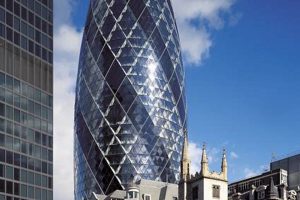Skyscraper glass is a type of architectural glass specifically designed for use in high-rise buildings. It is typically made of a laminated glass construction, with a layer of polyvinyl butyral (PVB) sandwiched between two or more layers of glass. This construction makes skyscraper glass strong and durable, able to withstand high winds and other extreme weather conditions.
In addition to its strength and durability, skyscraper glass also provides a number of other benefits. It can help to reduce heat gain and glare, making buildings more energy-efficient. It can also help to improve sound insulation, creating a more comfortable environment for occupants. And, because it is available in a variety of colors and finishes, skyscraper glass can be used to create a variety of aesthetic effects.
The use of skyscraper glass has become increasingly popular in recent years, as architects and engineers strive to create taller and more sustainable buildings. Today, skyscraper glass is used in some of the world’s most iconic buildings, including the Burj Khalifa in Dubai and the One World Trade Center in New York City.
1. Strength
Strength is a crucial aspect of skyscraper glass, as it ensures the safety and integrity of high-rise buildings. Skyscraper glass is engineered to withstand various external forces, including:
- Wind loads: Skyscraper glass must be able to resist high winds, especially in areas prone to hurricanes or cyclones. The laminated construction of skyscraper glass helps to distribute wind loads evenly, preventing the glass from shattering.
- Seismic forces: In earthquake-prone areas, skyscraper glass must be able to withstand the lateral forces generated by earthquakes. The PVB interlayer in skyscraper glass acts as a shock absorber, helping to reduce the risk of glass breakage.
- Impact resistance: Skyscraper glass must be able to resist impact from objects such as birds, hail, or debris. The outer layer of skyscraper glass is typically made of tempered glass, which is stronger and more resistant to breakage than annealed glass.
- Thermal stress: Skyscraper glass is exposed to extreme temperature changes, which can cause thermal stress. The PVB interlayer in skyscraper glass helps to reduce thermal stress by absorbing and dissipating heat.
The strength of skyscraper glass is essential for ensuring the safety of building occupants and the integrity of the building itself. By resisting external forces and maintaining its structural integrity, skyscraper glass contributes to the overall safety and performance of high-rise buildings.
2. Durability
Durability is a critical aspect of skyscraper glass, as it ensures the long-term performance and safety of high-rise buildings. Skyscraper glass is engineered to withstand various environmental factors and maintain its integrity over time, including:
- Weather resistance: Skyscraper glass must be able to withstand exposure to rain, snow, ice, and UV radiation. The outer layer of skyscraper glass is typically made of tempered glass, which is more resistant to weathering than annealed glass.
- Chemical resistance: Skyscraper glass must be able to resist chemical attack from pollutants in the air and cleaning agents. The PVB interlayer in skyscraper glass helps to protect the glass from chemical degradation.
- Abrasion resistance: Skyscraper glass must be able to resist abrasion from wind-blown sand and other particles. The outer layer of skyscraper glass is typically coated with a hard film to improve its abrasion resistance.
The durability of skyscraper glass is essential for ensuring the long-term safety and performance of high-rise buildings. By resisting environmental factors and maintaining its integrity over time, skyscraper glass contributes to the overall sustainability and value of high-rise buildings.
3. Energy efficiency
Skyscraper glass plays a crucial role in the energy efficiency of high-rise buildings. By controlling the amount of heat and light that enters a building, skyscraper glass can help to reduce energy consumption and create a more comfortable indoor environment.
- Reduced heat gain: Skyscraper glass can help to reduce heat gain in buildings by reflecting or absorbing solar radiation. This can help to reduce the need for air conditioning, leading to energy savings.
- Daylighting: Skyscraper glass allows natural light to enter buildings, which can reduce the need for artificial lighting. This can also lead to energy savings and improved occupant comfort.
- Insulation: Skyscraper glass can help to insulate buildings by reducing heat loss. This can help to reduce the need for heating, leading to energy savings.
- Low-emissivity coatings: Skyscraper glass can be coated with low-emissivity (low-e) coatings. These coatings reflect heat back into the building, helping to reduce heat loss. Low-e coatings can also help to reduce glare and improve occupant comfort.
The energy efficiency of skyscraper glass is an important consideration for architects and engineers. By using energy-efficient skyscraper glass, it is possible to reduce the energy consumption of high-rise buildings and create more sustainable and comfortable indoor environments.
4. Sound insulation
Sound insulation is a crucial aspect of skyscraper glass, as it helps to create a comfortable and productive indoor environment for building occupants. Skyscraper glass is engineered to reduce the transmission of sound through the building envelope, providing a quieter and more peaceful space inside the building.
- Laminated glass: Laminated glass is a type of skyscraper glass that consists of two or more layers of glass bonded together with a layer of polyvinyl butyral (PVB). The PVB layer helps to absorb and dissipate sound waves, reducing the transmission of sound through the glass.
- Double-glazed units: Double-glazed units (IGUs) are another type of skyscraper glass that consists of two panes of glass separated by a spacer. The spacer is filled with air or a gas, which helps to further reduce the transmission of sound through the glass.
- Acoustic glazing: Acoustic glazing is a specialized t
ype of skyscraper glass that is designed to provide even greater sound insulation. Acoustic glazing typically consists of multiple layers of glass, with each layer having a different thickness and composition. This helps to create a more effective sound barrier. - Soundproofing curtains: Soundproofing curtains can be used in addition to skyscraper glass to further reduce sound transmission. Soundproofing curtains are typically made of heavy, dense materials that help to absorb sound waves.
The sound insulation properties of skyscraper glass are essential for creating a comfortable and productive indoor environment in high-rise buildings. By reducing the transmission of sound through the building envelope, skyscraper glass helps to create a quieter and more peaceful space for building occupants.
5. Versatility
The versatility of skyscraper glass is one of its key advantages. It can be used in a wide variety of applications, from curtain walls to skylights to interior partitions. This versatility is due to the fact that skyscraper glass can be customized to meet the specific needs of a project. For example, it can be made in a variety of colors, finishes, and shapes. It can also be combined with other materials, such as metal and stone, to create unique and visually appealing facades.
The versatility of skyscraper glass also makes it a sustainable choice. It can be recycled and reused, and it can help to reduce energy consumption. For example, skyscraper glass can be used to create double-glazed units, which help to insulate buildings and reduce heat loss. It can also be used to create solar panels, which can generate electricity from sunlight.
The versatility of skyscraper glass is essential to its widespread use in modern architecture. It allows architects and engineers to create unique and sustainable buildings that meet the needs of their clients. As the demand for high-rise buildings continues to grow, the versatility of skyscraper glass will continue to be an important factor in its success.
6. Sustainability
Sustainability is a key consideration in the design and construction of modern skyscrapers. Skyscraper glass plays a significant role in achieving sustainability goals, as it can help to reduce energy consumption, greenhouse gas emissions, and waste.
One of the most important ways that skyscraper glass contributes to sustainability is by reducing heat gain. Heat gain is the transfer of heat from the outside to the inside of a building, which can lead to increased energy consumption for cooling. Skyscraper glass can be coated with low-emissivity (low-e) coatings, which reflect heat back to the outside of the building. This can help to reduce heat gain and the need for air conditioning, leading to energy savings.
Skyscraper glass can also be used to create double-glazed units (IGUs). IGUs consist of two panes of glass separated by a spacer. The spacer is filled with air or a gas, which helps to insulate the building and reduce heat loss. IGUs can help to reduce energy consumption for heating, leading to further energy savings.
In addition to reducing energy consumption, skyscraper glass can also help to reduce greenhouse gas emissions. Greenhouse gases are gases that trap heat in the atmosphere, leading to climate change. The production of traditional glass can release greenhouse gases into the atmosphere. However, there are now more sustainable ways to produce glass, such as using recycled glass or renewable energy sources. By using sustainable glass production methods, skyscraper glass can help to reduce greenhouse gas emissions and contribute to the fight against climate change.
Skyscraper glass can also be recycled at the end of its life, which helps to reduce waste and conserve resources. Recycled glass can be used to make new glass products, including skyscraper glass. This helps to close the loop and reduce the environmental impact of skyscraper glass.
The sustainability of skyscraper glass is an important consideration for architects, engineers, and building owners. By using sustainable glass production methods and incorporating energy-efficient features into skyscraper glass, it is possible to reduce the environmental impact of high-rise buildings and create more sustainable cities.
7. Safety
Skyscraper glass plays a crucial role in ensuring the safety of high-rise buildings and their occupants. It is engineered to withstand various threats and hazards, providing a secure and protective barrier against external forces.
- Impact Resistance: Skyscraper glass is designed to resist impact from objects such as birds, hail, and debris. The outer layer of the glass is typically made of tempered or laminated glass, which is stronger and more impact-resistant than annealed glass. This helps to prevent the glass from shattering and causing injury to occupants or damage to the building.
- Wind Resistance: Skyscraper glass is also designed to withstand high winds and wind-borne debris. The glass is typically installed in a curtain wall system, which distributes wind loads evenly across the facade. Additionally, the glass itself is often laminated, which helps to keep the glass in place even if it cracks or breaks.
- Fire Resistance: Skyscraper glass can be treated with fire-resistant coatings or interlayers to improve its resistance to fire. These coatings or interlayers help to slow the spread of flames and smoke, providing valuable time for occupants to evacuate the building. Fire-resistant skyscraper glass is often used in areas such as stairwells and elevator shafts.
- Security: Skyscraper glass can also be used to enhance the security of a building. Bullet-resistant glass can be used to protect against gunfire, while blast-resistant glass can be used to protect against explosions. Security glazing can also be used to deter break-ins and vandalism.
The safety features of skyscraper glass are essential for ensuring the well-being of building occupants and the integrity of the building itself. By providing protection against a variety of threats and hazards, skyscraper glass contributes to the creation of safe and secure high-rise environments.
8. Aesthetics
In the realm of modern architecture, skyscraper glass has emerged as a defining element, not only for its functional properties but also for its significant aesthetic value. The interplay between aesthetics and skyscraper glass is a multifaceted one, encompassing various aspects that contribute to the overall visual appeal and impact of high-rise structures.
- Transparency and Reflectivity: Skyscraper glass offers a unique blend of transparency and reflectivity, allowing buildings to interact with their surroundings in captivating ways. The transparent nature of glass provides unobstructed views, creating a sense of openness and connection between the interior and exterior spaces. Simultaneously, the reflective quali
ties of glass can transform buildings into shimmering beacons, reflecting the sky, clouds, and surrounding cityscape, adding dynamism and visual interest. - Color and Patterns: Modern advancements in glass technology have introduced a vast array of color and pattern options for skyscraper glass. Architects can now incorporate colored glass panels or apply decorative patterns to the glass surface, creating visually striking facades. These design elements can complement the architectural style of a building, enhance its branding, or simply add a touch of artistic flair to the urban landscape.
- Form and Shape: The versatility of skyscraper glass extends to its ability to conform to a wide range of shapes and forms. Curved glass panels, for example, can create sinuous and dynamic facades, breaking away from the traditional rectilinear forms of high-rise buildings. Complex geometric patterns can also be achieved through the use of custom-shaped glass panels, allowing architects to explore innovative and expressive designs.
- Light and Shadow: Skyscraper glass plays a crucial role in modulating natural light within buildings. The transparency of glass allows ample daylight to penetrate interior spaces, reducing the need for artificial lighting and creating a brighter, more welcoming environment. The reflective properties of glass can also be harnessed to control sunlight, reducing glare and heat gain while still allowing for natural light to enter the building.
In conclusion, the aesthetics of skyscraper glass encompass a multitude of factors, including transparency, reflectivity, color, patterns, form, shape, and the interplay of light and shadow. By carefully considering these elements, architects can design high-rise structures that are not only functional but also visually stunning, contributing to the overall beauty and character of the urban environment.
Skyscraper Glass FAQs
This section addresses frequently asked questions about skyscraper glass, providing concise and informative answers to common concerns and misconceptions.
Question 1: Is skyscraper glass safe?
Yes, skyscraper glass is designed and engineered to be extremely safe. It is typically made of laminated glass, which consists of two or more layers of glass bonded together with a strong interlayer. This construction makes skyscraper glass resistant to impact, wind loads, and other forces that could cause it to break.
Question 2: Can skyscraper glass help to reduce energy consumption?
Yes, skyscraper glass can help to reduce energy consumption in several ways. It can be coated with low-emissivity (low-e) coatings, which reflect heat back into the building in winter and out of the building in summer. Skyscraper glass can also be used to create double-glazed units, which are two panes of glass separated by a spacer. This helps to insulate the building and reduce heat loss.
Question 3: Is skyscraper glass sustainable?
Yes, skyscraper glass can be a sustainable choice. It can be made from recycled glass and can be recycled at the end of its life. Skyscraper glass can also help to reduce energy consumption, which can lead to reduced greenhouse gas emissions.
Question 4: Is skyscraper glass expensive?
The cost of skyscraper glass can vary depending on the type of glass, the size of the panels, and the complexity of the installation. However, skyscraper glass is generally more expensive than traditional glass. The cost of skyscraper glass is often offset by its durability, energy efficiency, and aesthetic appeal.
Question 5: What are the benefits of using skyscraper glass?
Skyscraper glass offers a number of benefits, including:
- Increased natural light
- Improved energy efficiency
- Reduced noise pollution
- Enhanced safety and security
- Aesthetic appeal
Question 6: What are the different types of skyscraper glass?
There are several different types of skyscraper glass, including:
- Annealed glass
- Tempered glass
- Laminated glass
- Insulating glass
- Low-e glass
The type of skyscraper glass that is used for a particular project will depend on the specific requirements of the project.
In conclusion, skyscraper glass is a safe, energy-efficient, sustainable, and aesthetically appealing material that can be used to create beautiful and functional high-rise buildings.
Transition to the next article section:
For more information on skyscraper glass, please see the following resources:
- Skyscraper Glass: A Guide to Types, Benefits, and Applications
- The Evolution of Skyscraper Glass Faades
- Skyscraper Glass: Design, Performance, and Applications
Skyscraper Glass Tips
Skyscraper glass offers a unique combination of strength, durability, energy efficiency, and aesthetics. By following these tips, you can ensure that you are getting the most out of your skyscraper glass:
Tip 1: Choose the right type of glass.
There are many different types of skyscraper glass available, each with its own unique properties. Consider the specific needs of your project when selecting the type of glass. For example, if you need a glass that is resistant to impact, you will need to choose a tempered or laminated glass. If you need a glass that is energy efficient, you will need to choose a low-e glass.
Tip 2: Install the glass properly.
The performance of skyscraper glass is highly dependent on the quality of the installation. Make sure that the glass is installed by a qualified professional. The installer should follow the manufacturer’s instructions carefully to ensure that the glass is properly sealed and secured.
Tip 3: Maintain the glass regularly.
Skyscraper glass should be cleaned regularly to remove dirt and debris. The frequency of cleaning will depend on the location of the building and the amount of exposure to the elements. Regular cleaning will help to keep the glass looking its best and will also help to prevent damage.
Tip 4: Inspect the glass regularly.
Skyscraper glass should be inspected regularly for damage. The inspector should look for cracks, chips, and other signs of damage. Any damage should be repaired as soon as possible to prevent further damage.
Tip 5: Replace the glass when necessary.
Skyscraper glass will eventually need to be replaced. The lifespan of the glass will depend on the type of glass, the quality of the installation, and the amount of exposure to the elements. When the glass is replaced, it is important to choose a qualified professional to do the job.
By following these tips, you can ensure that your skyscraper glass will perform well for many years to come.
Summary of key takeaways or benefits:
- Choosing the right type of glass and installing it properly will ensure that the glass meets your specific needs and performs as expected.
- Regular maintenance and inspections will help to keep the glass looking its best and prevent damage.
- Replacing the glass when necessary will ensure that the glass continues to perform well and provide the desired benefits.
Transition to the article’s conclusion:
Skyscraper glass is an important element of modern architecture. By following these tips, you can ensure that you are getting the most out of your skyscraper glass.
Conclusion
Skyscraper glass is a vital component of modern architecture, offering a unique combination of strength, durability, energy efficiency, and aesthetics. It has transformed
the design and construction of high-rise buildings, enabling the creation of taller, more sustainable, and more visually appealing structures.
The exploration of skyscraper glass in this article has highlighted its key properties and benefits. From its ability to withstand extreme forces and environmental factors to its role in reducing energy consumption and enhancing occupant comfort, skyscraper glass has proven to be an essential material in the quest for sustainable and innovative building design. As technology continues to advance, we can expect even more groundbreaking applications of skyscraper glass in the future, shaping the skylines of cities worldwide and redefining the boundaries of architectural possibilities.







